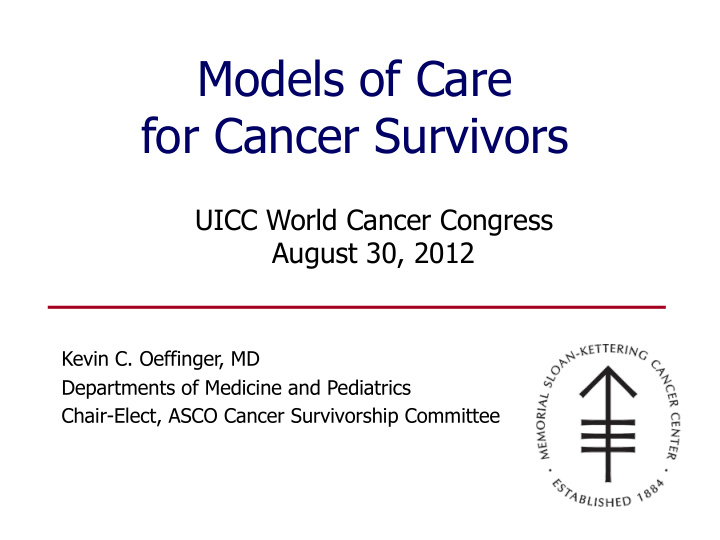



Models of Care for Cancer Survivors UICC World Cancer Congress August 30, 2012 Kevin C. Oeffinger, MD Departments of Medicine and Pediatrics Chair-Elect, ASCO Cancer Survivorship Committee
Questions and Issues • Risk-based survivorship health care • Risk-based survivorship health care • Who, where, how? • Health care system and setting – Hospital specialist vs GP outpatient – Tertiary cancer centers vs community oncologists • Are resources allocated where they are most needed? Does one size fit all? are most needed? Does one size fit all?
Es#mated)Number)of)Cancer)Survivors)in)the)United) States)from)1971)to)2007) 12'000'000 10'000'000 8'000'000 Number Over)14)million)) 6'000'000 cancer)survivors) 4'000'000 2'000'000 0 1971 1974 1977 1980 1983 1986 1989 1992 1995 1998 2001 2004 2007 NCI Office of Cancer Survivorship, based on SEER data, 2009
Traditional Model • Oncologist follows survivor for ‘lifetime’ • Focus is on surveillance for recurrence and persistent toxicity • Disconnect from other health care needs and lost in transition back to general health care needs
The average number of outpatient visits per year among 104,895 long-term cancer survivors (SEER-Medicare 1997-2003) 10 years after cancer • 8 physician visits per year • 1.6 visits with cancer doctor • 2.8 visits with primary care Pollack LA, et al. Cancer 2009
Proportion of 5-year breast cancer survivors (N=1,961) receiving recommended preventive care (SEER-Medicare) 100 90 80 70 Flu Vaccine 60 Cholesterol 50 CRC Screen 40 DXA 30 Mammogram 20 10 0 Neither Onc PCP Both Snyder CF, et al. JGIM, 2009
Long-Term and Late Effects • Second malignant neoplasms (SMN) – 16% of incident cancers are SMNs – Heightened risk from genetic factors, treatment exposures (radiation), lifestyles (smoking), aging, and multi-interactions • Cardiovascular disease – Cardiotoxic chemotherapy or radiation, lifestyles, aging …. • Other organ dysfunction / senescence • Aging and frailty
Conceptual Model: Frailty 1 Cancer 6 2 5 3 4 Adapted from Fried LP, J Gerontol 2001
Long-Term and Late Effects • Psychological outcomes – Anxiety and depression – Sense of uncertainty, fear of recurrence • Social outcomes – Changes in relationships – Economic / work / education impact
Long-Term and Late Effects • Psychological outcomes – Anxiety and depression – Sense of uncertainty, fear of recurrence • Social outcomes – Changes in relationships – Economic / work / education impact • Suboptimal care of non-cancer comorbidities
Cancer Survivor’s Risks • Risk of recurrence • Severity of long-term effect (toxicity) – Pulmonary dysfunction – Job loss, inability to return to work – Ongoing need for rehabilitation • Risk of late effect – Radiation-related second cancer – Anthracycline-related cardiomyopathy – Post traumatic stress or fears of recurrence
Risk-based survivor health care • Monitor for recurrence • Surveillance for second cancers and late effects [Early diagnosis and intervention] • Prevention [Tobacco use, physical activity, diet, calcium intake] • Counseling and targeted education • Specialized services [cancer rehabilitation]
Potential Barriers • 14 M increasing to 20 M by 2020 • Unclear patient desires and understanding of future health care needs • Shortage of oncologists • Shortage of primary care physicians • Individual financial incentives vs fixed (or shrinking) system resources • Lack of communication, education, and trust
Primary Care and Oncology Potosky AL, et al. J Gen Intern Med, 2011
Primary Care and Oncology • Different model preferences • Lack of trust • Difference in confidence levels Potosky AL, et al. J Gen Intern Med, 2011
Levels of Risk • Low risk 54-year-old breast cancer survivor 3 yrs post – lumpectomy and radiation [cancer surveillance] • Moderate risk 54-year-old breast cancer survivor also treated with – adjuvant chemo including doxorubicin and sequential trastuzumab [above plus heart and brain] • High risk 45-year-old leukemia survivor treated with allogeneic – hematopoietic stem cell transplant following total body irradiation
Low-Moderate Risk Models Eva Grunfeld Studies – transition of early stage breast cancer survivors to PCPs • Surveillance and detection of serious outcomes: PCP = Oncologist BMJ 1999 and J Clin Oncol 2006 • Survivorship care plan did not improve patient-reported outcomes [ J Clin Oncol 2011] – Low vs moderate risk – Longitudinal assessment of surveillance mammography and late effects in moderate risk group
Low-Moderate Risk
Moderate Risk • Initiation and counseling about surveillance • Targeted counseling during ‘teachable’ moment regarding physical activity and diet • Transition back to the community
Pa#entDCentered)Medical)Home) Improved Outcomes Developed by the MaColl Institute
High Risk • Multi-organ toxicity • Unusual (non-intuitive) late effects, such as metabolic derangements following bone marrow transplant • On going need for physical and psychosocial cancer rehabilitation
Future Directions Several international studies in progress: • Further elucidate patient, oncologist, primary care physician preferences • Study the transition process from oncologist to PCP – what is needed • Randomized clinical trials to test in other health care systems and patient populations
Future Directions • Test the utility of electronic health record and patient/physician portals • Determine the incidence of late effects (and mechanisms) • Develop risk prediction models to assist decision making (intensity, frequency, and setting of care)
Future Directions Bridging Primary Care and Oncology External Advisory Committee [K05CA160724] • Roland Goertz, MD, MBA AAFP President • J. Fred Ralston, Jr., MD ACP President • Douglas W. Blayney, MD ASCO President 2009-2010 • Peter C. Adamson, MD COG President • Joseph V. Simone, MD IOM 2003 Editor • Eva Grunfeld, MD, Dphil Knowledge Translation Network • Ellen Stovall IOM 2006; Editor, NCCS
Recommend
More recommend